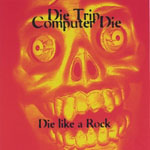|
|
 |
Dusted Reviews
Artist: Die Trip Computer Die Album: Die Like a Rock Label: Alcohol Review date: Oct. 17, 2006 |

|
|
|
 |
The question of irony is strangely moot on Die Trip Computer Die’s latest full-length, Die Like a Rock. The album’s title could be construed any number of ways, but from the hissed opening lines of “Glucose,” it’s hard to miss the group’s modus operandi: picking at the still-warm corpse of rock music in the early aughts. DTCD sounds nothing so much like an all-cassette jam party. This is the kind of music that clued-in eighth graders might make over a weekend with nothing but nineties alternative rock radio, The Residents, and Columbia House-scammed Who and Crispy Ambulance albums to inform their sense of rock music.
It seems painfully obvious to point it out, but it’s an idea that Die Like a Rock’s satisfyingly murky textures bring home with compelling freshness: rock music is about cannibalism. In other words, DTCD makes no concessions to narratives of sui generis rock genius. As a result, the album’s 10 songs manage to cut through a wide swath of musical territory – putting Coil’s sidereal laptop embellishments alongside syruped-down breakbeats on the above-mentioned “Glucose” – while maintaining a cognitive fuzziness that has less to do with recording fidelity than the internal logic of the songs themselves. “7th Beatle,” for example, sounds uncannily like a Faust homage improvised after a marathon viewing of the Beatles Anthology. If there is anything approaching a characteristic track for the album, this may be it: it chills out in an indeterminate fringe of near-nonsense, the kind of genre exercise that is too entropic to be academic.
And while there are big chunks of genre detritus that orbit around these songs, the overall effect is surprisingly coherent. It’s in this sense that the lyrics of “Glucose,” with their facile yet effective rhyme scheme, best approximates the band’s ‘whatever’s close at hand’ guerrilla semiotic: “I had a saccharine day / I nibbled some hay / I climbed up the tower / It took me an hour.” While even Brian Eno’s ‘panic’ lyrics – written in the shortest amount of time possible, under self-imposed mental stress – present a readable surface, these lyrics deliberately fail to refer to anything other than their own writing.
What’s crucially at stake here is the way that meaning and gesture are aligned in rock music, a concern that’s immediately apparent from the choice of cover art. At a time when skulls are enjoying substantial popularity in art, haute couture and mainstream graphic design, the manic skulls that grace the album’s cover and inner sleeve serve a specific semantic purpose, not just relating back to the cannibalism motif, but also playfully suggesting the death-drive mythology that upholds the notion of absolute, consuming originality.
Simply put, the band acts like its Anthology of Folk Music is the LAFMS box set – these are transmissions beamed in from the non-space between radio stations, the non-space of rock music’s tendency to both historicize and de-historicize itself. The position DTCD carve out for the listener isn’t radically new, but it is radically relevant, arising as it does from the negotiations between the avant-garde, rock and pop. DTCD proceeds slowly and sloppily enough with this album to fashion a kind of meta-rock that’s emphatically not about moustaches or unicorn-emblazoned Econoline vans; it’s about how we make sense (or fail to make sense) out of music, the ideas of discernment and choice that mediate our ideas of authenticity. It’s strange, has a non-uniform consistency and is full of bright green, felt-covered objects. Is it synthetic protest music?
By Brandon Bussolini
|







